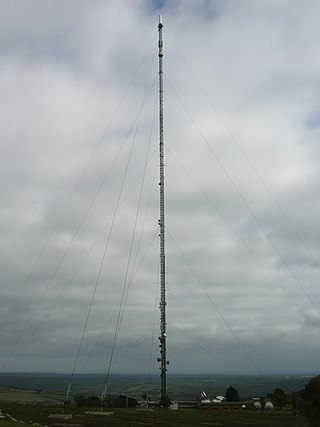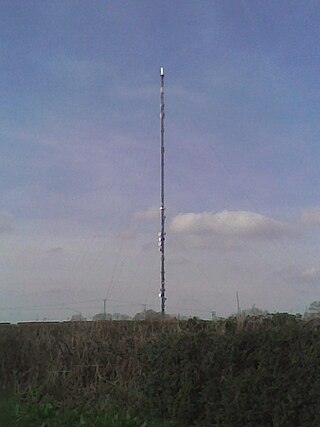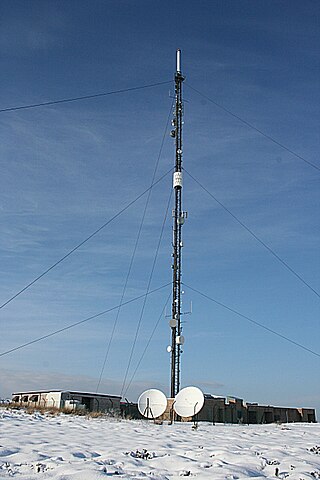Before they were decommissioned between 1982 and 1985, there were many instances of 405-line transmitters in the United Kingdom, having first been used in 1936. Below is a list of all transmitters:
Before they were decommissioned between 1982 and 1985, there were many instances of 405-line transmitters in the United Kingdom, having first been used in 1936. Below is a list of all transmitters:
Alexandra Palace in London hosted the first 405-line transmitter, active between 1936 and 1939, then again from 1946 through to 1956. From 1949 onwards, the Band I VHF 405-line BBC transmitter network grew quickly.
| Channel | Vision Carrier Frequency |
|---|---|
| B1 | 45.00 MHz |
| B2 | 51.75 MHz |
| B3 | 56.75 MHz |
| B4 | 61.75 MHz |
| B5 | 66.75 MHz |
In 1955, with the advent of ITV a parallel effort to provide a Band III network was also underway. The pre-1955 BBC stations used the five channels of Band I, but with the introduction of Band III, some BBC stations started appearing there too (most of them on channels 12 or 13). All ITV transmitters were in Band III (mostly on channels 8, 9, or 10).
| Channel | Vision Carrier Frequency |
|---|---|
| B6 | 179.75 MHz |
| B7 | 184.75 MHz |
| B8 | 189.75 MHz |
| B9 | 194.75 MHz |
| B10 | 199.75 MHz |
| B11 | 204.75 MHz |
| B12 | 209.75 MHz |
| B13 | 214.75 MHz |
There were eventually 41 high-power "main stations" owned by either the BBC or the IBA (see below). Most were built during the 1950s. The BBC's last main station to enter service was Belmont in Lincolnshire in November 1966; the IBA's last main station was the Welsh service from St. Hilary which went on-air in February 1965.
The main stations were supported by a large number of off-air relay stations to fill awkward gaps in the service from the main stations. The last of these (Llanelli in south Wales (BBC) and Newhaven in southeast England (IBA)) had been built by late 1970.
The entire system was decommissioned between 1982 and January 1985. [1]

The Crystal Palace transmitting station, officially known as Arqiva Crystal Palace, is a broadcasting and telecommunications site in the Crystal Palace area of the London Borough of Bromley, England. It is located on the site of the former television station and transmitter operated by John Logie Baird from 1933.

The Belmont transmitting station is a broadcasting and telecommunications facility next to the B1225, 1 mile (1.6 km) west of the village of Donington on Bain in the civil parish of South Willingham, near Market Rasen and Louth in Lincolnshire, England. It is owned and operated by Arqiva.

The Arfon transmitting station is a facility for FM, DAB digital radio and television transmission near the villages of Nebo and Nasareth in Gwynedd, northwestern Wales. It includes a 308.5 m (1,012 ft) guyed mast with antennas attached at various heights. The mast is surmounted by a television transmitting antenna, which brings the total height of the structure to 317.4 m (1,041 ft), making it the tallest structure in Wales. It is owned and operated by Arqiva.
The Llanddona transmitting station is a broadcasting and telecommunications facility, situated at Llanddona, near Beaumaris, on the isle of Anglesey, Wales. It comprises a 106.7 metres (350 ft) guyed mast with antennas attached at various heights. It is owned and operated by Arqiva.

The Wenvoe transmitting station, officially known as Arqiva Wenvoe, is the main facility for broadcasting and telecommunications for South Wales and the West Country. It is situated close to the village of Wenvoe in the Vale of Glamorgan, Wales, in the UK.

The Preseli transmitting station is a broadcasting and telecommunications facility on the eastern end of the Preseli Mountains, close to the villages of Crymych and Pentre Galar in Pembrokeshire, Wales. It is owned and operated by Arqiva.
The Oxford transmitting station is a broadcasting and telecommunications facility, situated on land 129.5 metres (425 ft) above Ordnance Datum to the north east of the city of Oxford, in Oxfordshire, England. It has a guyed steel lattice mast which is 154.4 metres (507 ft) in height to the top of the main steel structure. The UHF television antenna, which consist of a vertical array of transmitting panels, is mounted above the steel structure. The total height of the mast to the top of this UHF antenna is 165.7 metres (544 ft). It is owned and operated by Arqiva.
Analogue terrestrial television in the United Kingdom was originally the method by which the significant majority of viewers in the UK, the Channel Islands and the Isle of Man received television. Analogue terrestrial television broadcasts have fully ceased in the UK with Northern Ireland being the last region to have ceased transmission analogue terrestrial television broadcasts. Northern Ireland switched off the last analogue television signals, making all of the United Kingdom only capable of receiving digital television, in the early hours of 24 October, 2012. It has been completely replaced by digital terrestrial television and other non-terrestrial means as of the end of 2012.

The Stockland Hill transmitting station is a transmitting facility of FM Radio and UHF television located near Honiton, Devon, England.

Les Platons is the highest point of Jersey, a British Crown dependency, with an elevation of 136 metres (446 ft). It is located in the Vingtaine de la Ville-à-l'Évêque in the parish of Trinity.

Brougher Mountain transmitting station is a major transmitting station in Northern Ireland. It is located between County Tyrone and County Fermanagh, on top of a 317 m (1,040 ft) high hill called Brougher Mountain.
The Brecon transmitting station was originally built by the IBA in 1970 as a relay for VHF 405-line analogue television: one of the last 405-line TV stations to be built in Britain. As built, it consisted of a 46 m guyed lattice mast carrying the aerials at the top. This structure was built about 300 m NW of Slwch Tump Iron Age hill fort on the slopes of a 240 m hill known as "The Slwch" overlooking the town. The VHF television feed was provided off-air from Abergavenny, about 25 km to the southeast - itself an off-air relay of St. Hilary near Cardiff.
The Llandrindod Wells transmitting station is a broadcasting and telecommunications facility located on high ground about midway between Llandrindod Wells and Rhayader, in Powys, Wales. It was originally built by the BBC, entering service in 1961 transmitting the now-defunct 405-line VHF television system and the original three FM radio services.
The Abergavenny transmitting station was originally built by the IBA in 1969 as a relay for BBC and ITV VHF 405-line analogue television. It consists of a 46 m guyed lattice mast carrying the aerials at the top. This structure was built on a 440 m hill known as Gilwern Hill overlooking the towns of Gilwern and Abergavenny in Monmouthshire, South Wales. The band III VHF television feeds were provided off-air from St. Hilary and Wenvoe, both near Cardiff.
The Llandovery transmitting station is a telecommunications facility located to the north of Llandovery and east of Cynghordy, in Carmarthenshire, Wales. It has a self-supporting 40 m lattice mast erected on land that is itself about 312 m above sea level. The site was originally built by the IBA, entering service in 1968 transmitting the now-defunct 405-line VHF television system. As well as providing an ITV service to the town of Llandovery some 8 km to the south west the site also transmitted to the north east, primarily to provide a link-signal for the ITV transmitter at Llandrindod Wells. The north easterly transmission also provided the ITV service to the villages of Llanwrtyd Wells and Llangammarch Wells.
The Ffestiniog transmitting station is a broadcasting and telecommunications facility located on the slopes of Mynydd Maentwrog about 3 kilometres (1.9 mi) south of the town of Llan Ffestiniog, in Gwynedd, Wales. It was originally built by the IBA, entering service in early 1969 acting as a BBC and ITV relay transmitter for the now-defunct 405-line VHF television system.
The Dolgellau transmitting station is a broadcasting and telecommunications facility located on a hill about 1 km north of the town of Dolgellau, in Gwynedd, Wales. It was originally built by the BBC, entering service just before Christmas 1967 acting as a relay transmitter for the now-defunct 405-line VHF television system.

Divis transmitting station is the main high-power UHF and BBC National FM/DAB station that serves Belfast, County Antrim and parts of County Down.
This is a timeline of the history of the British broadcaster Grampian Television. It provided the ITV network service for the north of Scotland between 1960 and 2006.

The Knock More transmitting station is a broadcasting facility, located at Knock More, to east of the parish of Boharm, Scotland, in Moray. It is a guyed steel lattice mast which stands 113 metres (371 ft) high. The mast is located on elevated ground which is about 355 m above sea level, and is between Elgin and Keith. It was built by the Independent Broadcasting Authority (IBA) to improve and extend UHF television coverage in north east Scotland, and is now owned and operated by Arqiva.